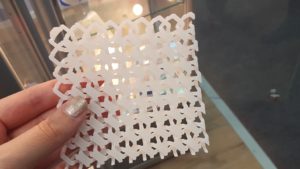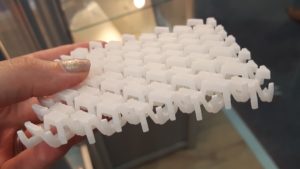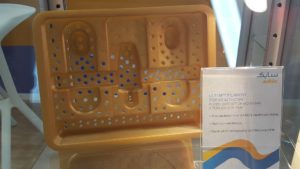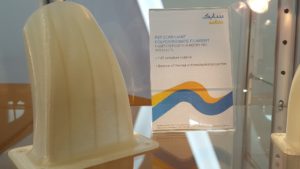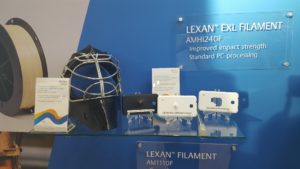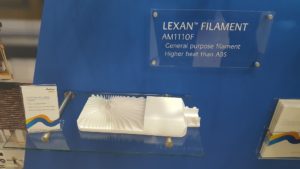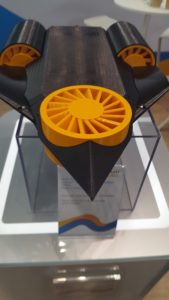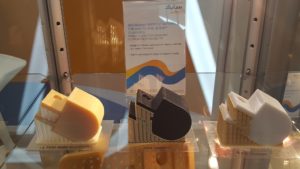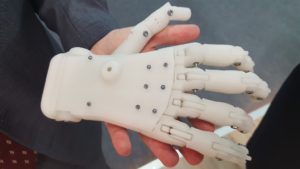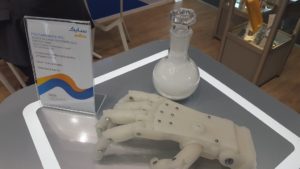 As hardware and software continue to develop apace in additive manufacturing, some of the greatest potential for the future of 3D printing technologies can be seen a step back in the supply chain as materials increasingly come into the spotlight. The recent, massive, formnext event held in Frankfurt housed 470 exhibitors this year — among them were some of the biggest names in global materials science, including DSM, BASF, and SABIC. At SABIC‘s booth, I met again with the company’s Senior Business Manager, Additive Manufacturing Specialities, Keith Cox, whom I last saw at RAPID + TCT, where the company introduced a wealth of new 3D printing materials.
As hardware and software continue to develop apace in additive manufacturing, some of the greatest potential for the future of 3D printing technologies can be seen a step back in the supply chain as materials increasingly come into the spotlight. The recent, massive, formnext event held in Frankfurt housed 470 exhibitors this year — among them were some of the biggest names in global materials science, including DSM, BASF, and SABIC. At SABIC‘s booth, I met again with the company’s Senior Business Manager, Additive Manufacturing Specialities, Keith Cox, whom I last saw at RAPID + TCT, where the company introduced a wealth of new 3D printing materials.
Following the company’s inaugural showing at RAPID, this formnext marked another first exhibition for SABIC as the company continues to delve more deeply into additive manufacturing.
“Our vision is consistent,” Cox told me.
“We are bringing additive manufacturing into end-use applications, and we will enable this any way we can. We bring ability as a material supplier and a process developer. What drives growth is unique materials that enable new applications, which allow OEMs to do more — we want to enable this.”
SABIC, Cox detailed, is working with three primary focuses in 3D printing technology:
- FDM (FFF), which he describes as being the most straightforward
- Large-format, such as work with Livrea Yachts and Big Area Additive Manufacturing (BAAM)
- Laser sintering, notably SLS
Materials standards are driving all of the efforts here, with work fostered by investments on the process side and in new printing technologies. SABIC has global operations at its disposal, including among them its headquarters in Riyad and capabilities in Massachusetts and the Netherlands.
Launches at RAPID centered around BAAM technologies as well as their drop-in refill solutions for Stratasys’ Fortus line of FDM 3D printers; these have been commercialized and provide a filament and chip technology that can be read by the Fortus machines. Focus for SABIC is on differentiating materials, and new developments continued with additional launches in the company’s high-performance THERMOCOMP AM compound family.
A high-impact material based on SABIC’s proprietary polycarbonate technology and designed for use in additive manufacturing, Cox explained, has been commercialized and is available for use in Stratasys machines as well as in any appropriate, high-temperature machine. SABIC is additionally looking to commericalize materials targeting healthcare, such as a polycarbonate ULTEM material, and for aerospace.
On the large-format site, Cox said, SABIC has been continuing to work wtih Livrea, as well as with Local Motors and service bureaus.
“We have capabilities to print in-house, which helps with material and process development,” he explained.
SABIC is also “advancing technologies to allow amorphous materials for use in SLS,” Cox said, as the company works with advanced polycarbonate to print 96-97% dense, fully amorphous parts. These capabilities lead to no worries about part dimensions, contrasting with what is often seen using PA-12. This material, he noted, is not yet commercial, and is in sights for 2018. The focus in working with polycarbonate is to optimize the 3D printing process, surface quality, complexity, and finish possible.
As we looked at different materials showcased around the booth, Cox pointed out their LEXAN EXL filament, which has 4x the impact resistance of previous materials. While standard polycarbonate has a brittle failure, he noted as well, this offers a “much more ductile failure” that offers benefits in impact performance sought after in sporting equipment — such as a displayed helmet — and in drone design.
In 2018, SABIC will also be introducing more FST-compliant materials, as well as support materials.
“We are continuing to optimize materials and capabilities. We are applying this to other materials for SLS, and adapting to the processes that customers use,” Cox told me.
“There’s value in our moving directly into the supply value chain and producing consumables directly.”
Discuss formnext 2017, and other 3D printing topics, at 3DPrintBoard.com or share your thoughts in the Facebook comments below.
[All photos: Sarah Goehrke]
Subscribe to Our Email Newsletter
Stay up-to-date on all the latest news from the 3D printing industry and receive information and offers from third party vendors.
You May Also Like
Profiling a Construction 3D Printing Pioneer: US Army Corps of Engineers’ Megan Kreiger
The world of construction 3D printing is still so new that the true experts can probably be counted on two hands. Among them is Megan Kreiger, Portfolio Manager of Additive...
US Army Corps of Engineers Taps Lincoln Electric & Eaton for Largest 3D Printed US Civil Works Part
The Soo Locks sit on the US-Canadian border, enabling maritime travel between Lake Superior and Lake Huron, from which ships can reach the rest of the Great Lakes. Crafts carrying...
Construction 3D Printing CEO Reflects on Being Female in Construction
Natalie Wadley, CEO of ChangeMaker3D, could hear the words of her daughter sitting next to her resounding in her head. “Mum, MUM, you’ve won!” Wadley had just won the prestigious...
1Print to Commercialize 3D Printed Coastal Resilience Solutions
1Print, a company that specializes in deploying additive construction (AC) for infrastructure projects, has entered an agreement with the University of Miami (UM) to accelerate commercialization of the SEAHIVE shoreline...



